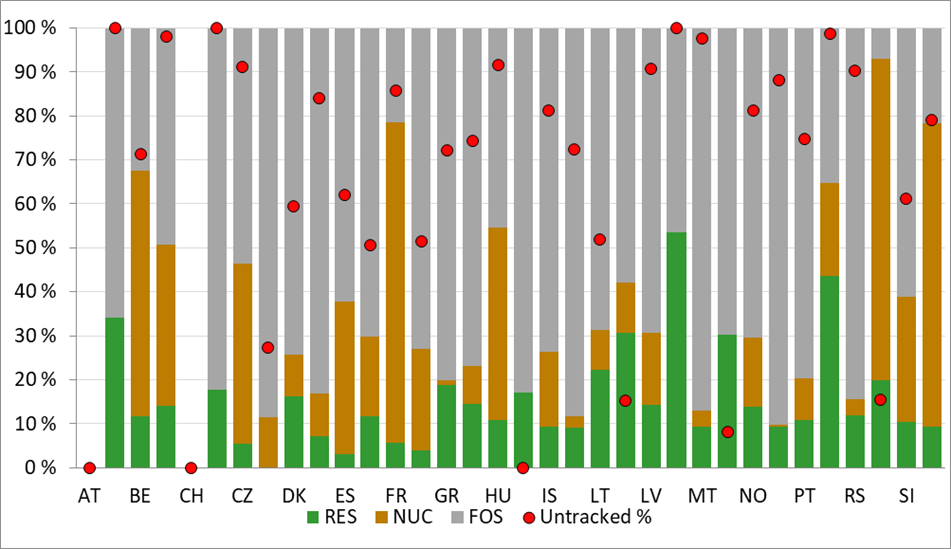2022
AIB has published the Residual Mixes and European Attribute Mix of 2022. These figures represent the part of electricity supply in Europe that is not tracked with guarantes of origin and therefore guaranteeing the accuracy and reliability of the GO system.
These figures represent the part of electricity supply in Europe that is not tracked with guarantees of origin and therefore guaranteeing the accuracy and reliability of the GO system. The calculation was carried out by Grexel Systems Ltd on behalf of AIB.
The 2022 calculation marks the fourth consecutive year in which the AIB Residual Mix calculation has been carried out according to the Shifted Issuing Based Methodology. Using this methodology, results continue to be consistent year-on-year.
To summarise: In contrast to a rise in 2021 for levels of production for all energy sources, we see a dip in overall production. Total electricity production decreased by 91 TWh in the calculation area from 2021. The sharpest decrease was in nuclear production, which declined by 120 TWh, while fossil generation increased by 25 TWh and renewables remained at 2021 level.
Energy tracking volumes continue to rise. Compared to 2021, the total recorded issuance volume was 40 TWh (3,1%) higher in 2022. Cancellations rose by 70 TWh (5,7%) respectively. Notably, the share of untracked renewables from all untracked attributes decreased from 11,4% in 2021 to 9,1% in 2022.
The total amount of untracked renewables decreased from 221 TWh in 2021 to 165 TWh in 2022 (-25%) in the whole calculation area. By average, there was 4 %-points lesser renewable share in the residual mixes of the countries compared to 2021 (18,7% in 2021 to 14,7% in 2022). All in all, a continuously decreasing amount of renewables is left untracked.
Regarding CO2 emissions, this year for the first time, the Ecoinvent data was used as input factors to replace the input emission factors calculated in the RE-DISS project. This increased the amount of CO2 emissions in the residual mix of many countries, even without a notable increase in the fossil share.
The European Attribute Mix for 2022 is 9,22% renewable, 17,02% nuclear and 73,76% fossil.
This EAM fills a gap for countries that export such quantities of GOs that there are not sufficient domestic attributes left to determine the origin of all the domestic electricity consumption. The shares of energy sources in the EAM come from countries that import such quantities of GOs that they result in a domestic surplus of attributes compared to domestic supply. The change in last year is renewables: -0,70 percentage points (pp), nuclear: -7,36pp and fossil: +8,05pp.

Highlighted results from the calculation:
- In line with the EAM, on average the residual mixes showed a decrease in the renewable share: from 18,7% in 2021 to 14,7% in 2022 (-4pp). Respective values for nuclear were 22,8% and 19,0% (-3,8pp) as well as for fossil 55,6% and 60,4% (+4,8pp).
- The volume of reliably-tracked electricity grew from 1256 TWh to 1327 TWh (total recorded cancellations).
- The share of untracked consumption has continued to decrease and is now 58,9% (down from 61,1% for 2021).
Country specific highlights from the results:
- Switzerland has joined the list of countries with full disclosure of electricity and no longer has a residual mix.
- Finland has started issuance of nuclear GOs, which is notable in the declined nuclear share of the residual mix.
- France’s significantly decreased nuclear power production caused a major attribute deficit in France for the first time in the calculation. Previously, the country has been a major surplus country in relation to the European Attribute Mix.
- Overall, RES shares decreased in the residual mix, most rapidly in Latvia and Portugal.
Download the full report for more insights.
Download Excel datasheet for numeric values.
Recalculation of historic Emission Factors (for background information only)
With the publication of these Residual Mixes for the calendar year 2022, the emission factors (EFs) for the individual fuel categories were changed compared to previous years. In order to support the understanding of the impact of the transition from the previous set of emission factors, originating from the RE-DISS project, to the new set of underlying EFs, the direct emissions of the previous three years of residual mix calculations (2019-2021) have been recalculated based on the new set of EFs. This has been done in an appendix to the report. It is NOT the intention to retroactively update the historic emission factors: the disclosure figures of the previous years stay as they have been communicated at that time by the national authorities.

